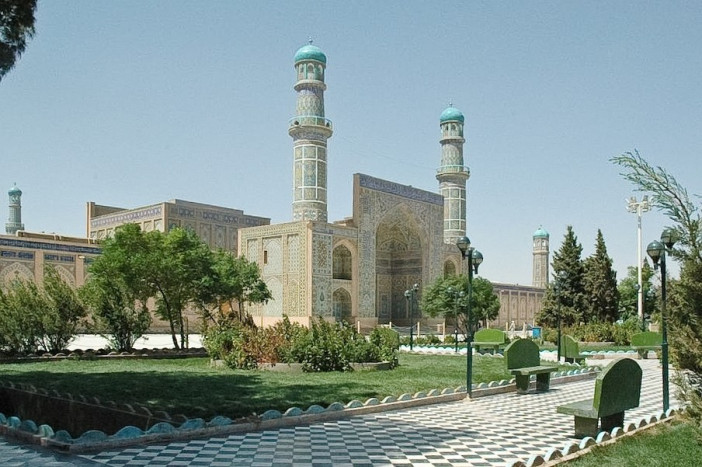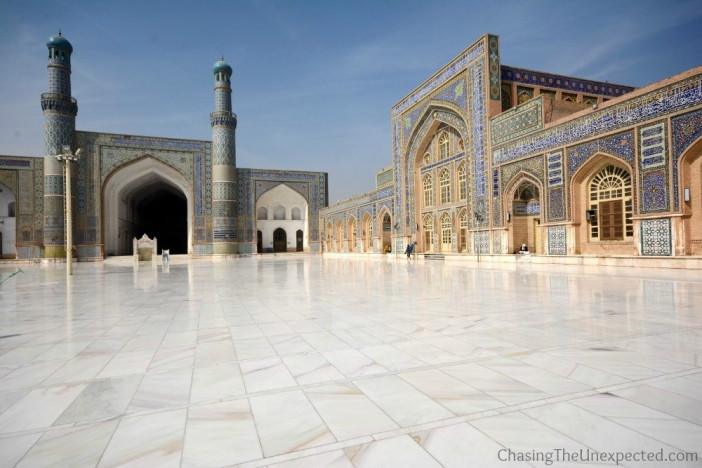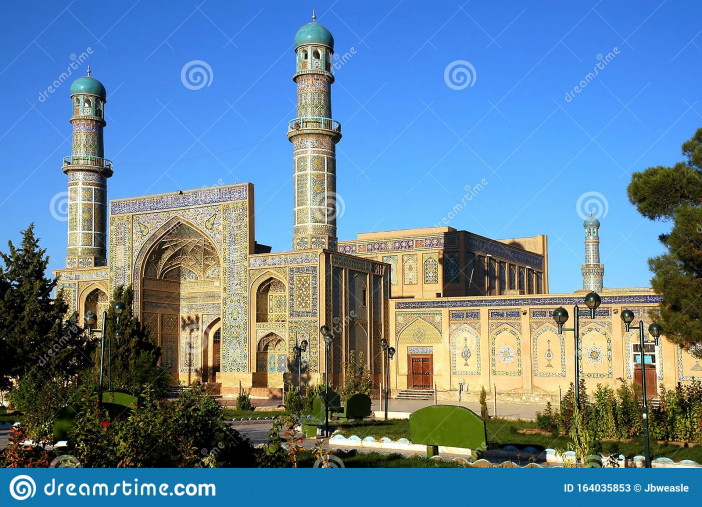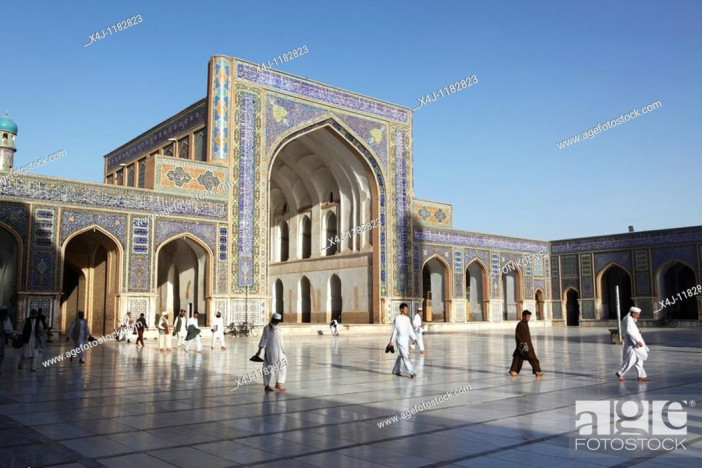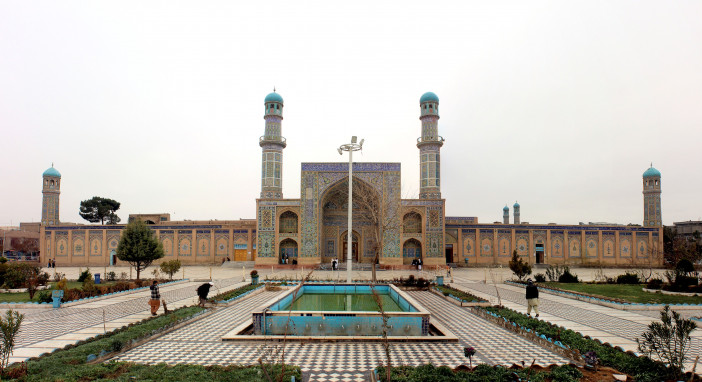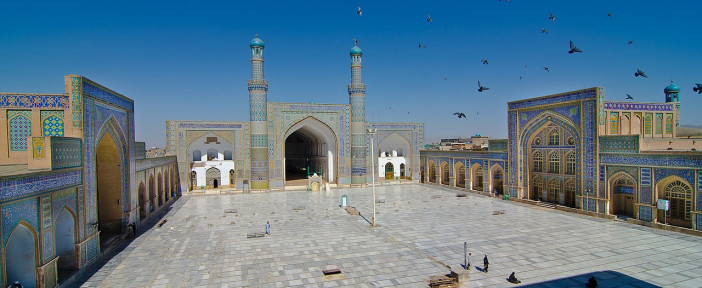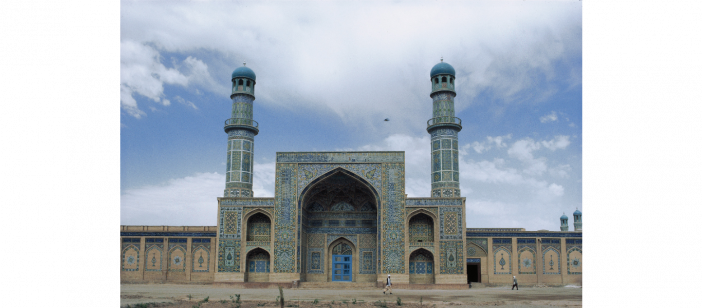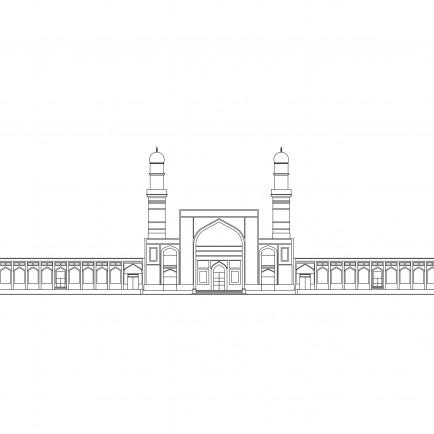Great Mosque of Herat
History
The Masjid-i Jami of Herat was the city's first congregational mosque. It was built on a site where religious sites had been located for many centuries.The first known building was a Zoroastrian temple converted into a mosque in the 7th century. Afterward, it was enlarged by the Turkic Ghaznavids. In the second half of the 11th century, a Herat mosque was founded under the rule of the Khwarazmian dynasty. It had a wooden roof and was of smaller dimensions than the following buildings. During an earthquake in 1102, it was almost completely destroyed but was rebuilt. Later it was ruined by a fire. Subsequently, the Ghurids constructed a mosque on the existing and adjacent plots. After repair works in 1913, the mosque was extensively renovated in 1942/1943. The buildings directly adjacent to the mosque were destroyed in order to make the mosque a free-standing building. Among other things, a new east entrance with a high archway and two minarets was built. Minarets are towers from which people are called to prayer. The exterior walls were decorated with glazed tiles in the Timurid style. For these works, a ceramic tile studio was established by UNESCO. This studio in the mosque also preserved all tile decorations and mosaics until 1979. The lettering was substituted by current calligraphers.
The follow-up was a more complete reconstruction from 1951 to 1973 involving structural changes. The square dome of the mausoleum of the Ghurid time was widely destroyed. It was replaced by an octagonal construction and integrated in the northern front. The wall to the east was also changed into an iwan with minarets on both sides. Also, the maqsura iwan, an enclosure reserved for the ruler, was made higher. The minarets next to it were heightened to 35 meters tall. Its porch was renewed. In addition, ten new minarets were added. The facades in the courtyard were tiled with traditional mosaics in seven different colors. The floor was paved with light brown baked bricks. Due to all these works, not much of the original Ghuridic plasterwork or Timurid decoration was visible. The mosque's madrassa was moved to the northeast and given its own entrance. The last significant change was the creation of a park in front of the mosque.
During the Soviet-Afghan War (1979-1989), only limited demolition struck the mosque. This was the case despite the abuse of the minarets by Soviet soldiers and huge tanks moving around the area. In 1986 one minaret hit by a rocket crashed into the courtyard. It killed many people and caused damage to the eastern wing. The Soviets sent experts for reparation, but works have not been finished until 1995. Some more traces like bullet holes could be found. The Ghurid portal was not severely damaged.
In 1992 the replacing of the stone plaster in the courtyard started, financed by private sponsoring. A pattern of wide strips of white marble alternating with narrow stripes of black marble was laid. Due to failing donations, it could not be finished until 1998. During the Taliban's rule in Herat between 1996 and 2001, the entry to the mosque was banned for all non-muslims, including UN staff. In 2002, all roofs of the mosque were renovated due to a problem with excessive humidity in the interior. During the renovation of the facades in 2004/05, parts of the old Ghurid decoration were found. These parts are exhibited in frames in the wall covering. In 2012, some fifty Afghan traders promised funds for the renovation of the mosque.
Urban and Architectural
The initial plan of the mosque by the Ghurids
The Ghurids built the entire mosque using brick. The layout is a typical 4-iwan plan with an interior courtyard and a water basin. The qibla orientation towards the west was adhered to, although this deviates from the correct direction to Mecca by about 20°. The main iwan was covered by vaults. It formed an axial cross with the other three iwans on each side of the courtyard. These three iwans were intended as meeting and teaching places for smaller audiences. Mosque at present
The mosque complex is 180 meters long and 120 meters wide, covering an area of about 21,600 square meters. Besides the four large iwans, there are 460 domes, 444 pillars, and 12 minarets (17–36 meters tall). These elements are grouped around the central courtyard (82m by 60m).Pishtaqs, the gateways to the iwan, underline the spatial importance of the iwans. Together with the depth of the iwans, they provide a large surface for ornamentation.A significant part of the present mosque is covered with glazed tiles in bright colors according to Timurid tradition. Decoration from the Ghurid period in the present mosque
In the southern and western iwan interior, decorative elements of the Ghurid period are uncovered. Made from stucco, they are stamped with floral and geometric patterns. Stucco is a material for molding ornaments.At the southeast corner of the mosque is the Ghurid portal. It has not served as a portal since unknown times. On both sides of the archway, Kufic inscriptions are displayed. This style of Arabic script is typical of Ghurid period inscriptions. The vertically placed bands of inscriptions are made of terracotta and worked into the base's mortar like a mosaic. On the front, they are glazed blue, contrasting with the light red brick tone of the background.The sidewalls of the portal are decorated with geometrical brick mosaic, interspersed with blue glazed tile plugs.
Description
The Great Mosque of Herat (Pashto: د هرات لوی جومات ; Dari: مسجد جامع هرات, romanized: Masjid-i Jāmi‘-i Herāt) or "Jami Masjid of Herat",is a mosque in the city of Herat, in the Herat Province of north-western Afghanistan. It was built by the Ghurids, under the rule of Sultan Ghiyath al-Din Muhammad Ghori, who laid its foundation in 1200 CE. Later, it was extended several times as Herat changed rulers down the centuries from the Kartids, Timurids, Mughals and then the Uzbeks, all of whom supported the mosque. The fundamental structure of the mosque from the Ghurid period has been preserved, but parts have been added and modified. The Friday Mosque in Herat was given its present appearance during the 20th century. The entrance corridors are to either side of this, but they are frequently locked outside the main prayer hours, forcing visitors to gain access to the mosque proper via the small street entrance on its northern wall. This is actually a more atmospheric choice, as the cool dark of the entrance corridor suddenly gives way to a bright sunburst of colour as you enter the main courtyard. The mosque is laid out in a classical plan of four iwans (barrel-vaulted halls) with arcaded walls around a central courtyard nearly 100m long. Two huge minarets flank the main iwan. Almost every square centre is covered in breathtaking mosaic, surrounded by blue bands of Quranic script. Only the simple whitewash of the iwans adds a note of modesty. The minarets, with their repeated bands of stylised flowers, arabesques and geometric patterns are simply dizzying. The mosque was originally laid out by the Ghorid Sultan Ghiyasuddin in 1200. Originally it would have had quite a different appearance, as the Ghorids preferred plain brick and stucco decoration. The Timurids restored the mosque in the 15th century and introduced the bright mosaic, but by the early 20th century so much of this had been lost that visitors remarked on the mosque’s dullness. The lavish tiling that now covers the mosque is the product of the mosque’s tile workshop, an ongoing restoration project since the 1940s. While many of the mosaics are based on Timurid originals, the workshop has also introduced its own designs, colours and calligraphy.
References
https://en.wikipedia.org/wiki/Great_Mosque_of_Herat https://www.lonelyplanet.com/afghanistan/herat-and-northwestern-afghanistan/herat/attractions/friday-mosque/a/poi-sig/451127/355747 https://dbpedia.org/page/Great_Mosque_of_Herat#
https://www.dreamstime.com/herat-western-afghanistan-great-mosque-herat-friday-mosque-jama-masjid-mosque-decorated-mosaics-image164035853
Details
Location
Herat, Afghanistan, 34°20′35″N 62°11′45″E
Year of Build
1942/1943
Area
21,600 square meters
Drawings
Map
History
The Masjid-i Jami of Herat was the city's first congregational mosque. It was built on a site where religious sites had been located for many centuries.The first known building was a Zoroastrian temple converted into a mosque in the 7th century. Afterward, it was enlarged by the Turkic Ghaznavids. In the second half of the 11th century, a Herat mosque was founded under the rule of the Khwarazmian dynasty. It had a wooden roof and was of smaller dimensions than the following buildings. During an earthquake in 1102, it was almost completely destroyed but was rebuilt. Later it was ruined by a fire. Subsequently, the Ghurids constructed a mosque on the existing and adjacent plots. After repair works in 1913, the mosque was extensively renovated in 1942/1943. The buildings directly adjacent to the mosque were destroyed in order to make the mosque a free-standing building. Among other things, a new east entrance with a high archway and two minarets was built. Minarets are towers from which people are called to prayer. The exterior walls were decorated with glazed tiles in the Timurid style. For these works, a ceramic tile studio was established by UNESCO. This studio in the mosque also preserved all tile decorations and mosaics until 1979. The lettering was substituted by current calligraphers.
The follow-up was a more complete reconstruction from 1951 to 1973 involving structural changes. The square dome of the mausoleum of the Ghurid time was widely destroyed. It was replaced by an octagonal construction and integrated in the northern front. The wall to the east was also changed into an iwan with minarets on both sides. Also, the maqsura iwan, an enclosure reserved for the ruler, was made higher. The minarets next to it were heightened to 35 meters tall. Its porch was renewed. In addition, ten new minarets were added. The facades in the courtyard were tiled with traditional mosaics in seven different colors. The floor was paved with light brown baked bricks. Due to all these works, not much of the original Ghuridic plasterwork or Timurid decoration was visible. The mosque's madrassa was moved to the northeast and given its own entrance. The last significant change was the creation of a park in front of the mosque.
During the Soviet-Afghan War (1979-1989), only limited demolition struck the mosque. This was the case despite the abuse of the minarets by Soviet soldiers and huge tanks moving around the area. In 1986 one minaret hit by a rocket crashed into the courtyard. It killed many people and caused damage to the eastern wing. The Soviets sent experts for reparation, but works have not been finished until 1995. Some more traces like bullet holes could be found. The Ghurid portal was not severely damaged.
In 1992 the replacing of the stone plaster in the courtyard started, financed by private sponsoring. A pattern of wide strips of white marble alternating with narrow stripes of black marble was laid. Due to failing donations, it could not be finished until 1998. During the Taliban's rule in Herat between 1996 and 2001, the entry to the mosque was banned for all non-muslims, including UN staff. In 2002, all roofs of the mosque were renovated due to a problem with excessive humidity in the interior. During the renovation of the facades in 2004/05, parts of the old Ghurid decoration were found. These parts are exhibited in frames in the wall covering. In 2012, some fifty Afghan traders promised funds for the renovation of the mosque.
Urban and Architectural
The initial plan of the mosque by the Ghurids
The Ghurids built the entire mosque using brick. The layout is a typical 4-iwan plan with an interior courtyard and a water basin. The qibla orientation towards the west was adhered to, although this deviates from the correct direction to Mecca by about 20°. The main iwan was covered by vaults. It formed an axial cross with the other three iwans on each side of the courtyard. These three iwans were intended as meeting and teaching places for smaller audiences. Mosque at present
The mosque complex is 180 meters long and 120 meters wide, covering an area of about 21,600 square meters. Besides the four large iwans, there are 460 domes, 444 pillars, and 12 minarets (17–36 meters tall). These elements are grouped around the central courtyard (82m by 60m).Pishtaqs, the gateways to the iwan, underline the spatial importance of the iwans. Together with the depth of the iwans, they provide a large surface for ornamentation.A significant part of the present mosque is covered with glazed tiles in bright colors according to Timurid tradition. Decoration from the Ghurid period in the present mosque
In the southern and western iwan interior, decorative elements of the Ghurid period are uncovered. Made from stucco, they are stamped with floral and geometric patterns. Stucco is a material for molding ornaments.At the southeast corner of the mosque is the Ghurid portal. It has not served as a portal since unknown times. On both sides of the archway, Kufic inscriptions are displayed. This style of Arabic script is typical of Ghurid period inscriptions. The vertically placed bands of inscriptions are made of terracotta and worked into the base's mortar like a mosaic. On the front, they are glazed blue, contrasting with the light red brick tone of the background.The sidewalls of the portal are decorated with geometrical brick mosaic, interspersed with blue glazed tile plugs.
Description
The Great Mosque of Herat (Pashto: د هرات لوی جومات ; Dari: مسجد جامع هرات, romanized: Masjid-i Jāmi‘-i Herāt) or "Jami Masjid of Herat",is a mosque in the city of Herat, in the Herat Province of north-western Afghanistan. It was built by the Ghurids, under the rule of Sultan Ghiyath al-Din Muhammad Ghori, who laid its foundation in 1200 CE. Later, it was extended several times as Herat changed rulers down the centuries from the Kartids, Timurids, Mughals and then the Uzbeks, all of whom supported the mosque. The fundamental structure of the mosque from the Ghurid period has been preserved, but parts have been added and modified. The Friday Mosque in Herat was given its present appearance during the 20th century. The entrance corridors are to either side of this, but they are frequently locked outside the main prayer hours, forcing visitors to gain access to the mosque proper via the small street entrance on its northern wall. This is actually a more atmospheric choice, as the cool dark of the entrance corridor suddenly gives way to a bright sunburst of colour as you enter the main courtyard. The mosque is laid out in a classical plan of four iwans (barrel-vaulted halls) with arcaded walls around a central courtyard nearly 100m long. Two huge minarets flank the main iwan. Almost every square centre is covered in breathtaking mosaic, surrounded by blue bands of Quranic script. Only the simple whitewash of the iwans adds a note of modesty. The minarets, with their repeated bands of stylised flowers, arabesques and geometric patterns are simply dizzying. The mosque was originally laid out by the Ghorid Sultan Ghiyasuddin in 1200. Originally it would have had quite a different appearance, as the Ghorids preferred plain brick and stucco decoration. The Timurids restored the mosque in the 15th century and introduced the bright mosaic, but by the early 20th century so much of this had been lost that visitors remarked on the mosque’s dullness. The lavish tiling that now covers the mosque is the product of the mosque’s tile workshop, an ongoing restoration project since the 1940s. While many of the mosaics are based on Timurid originals, the workshop has also introduced its own designs, colours and calligraphy.


